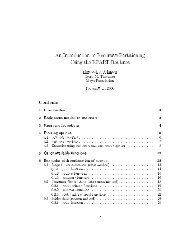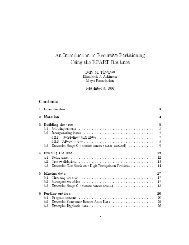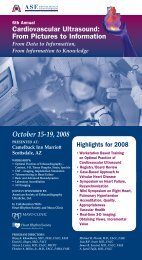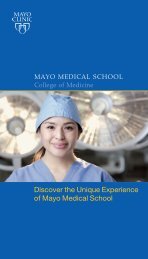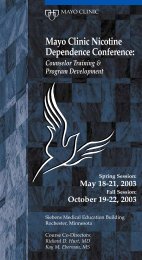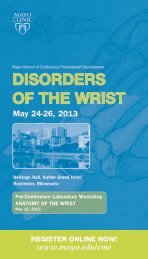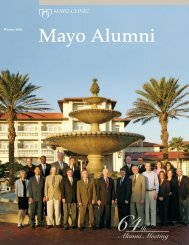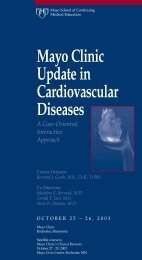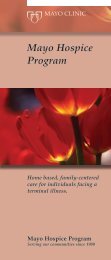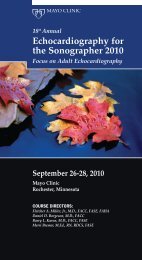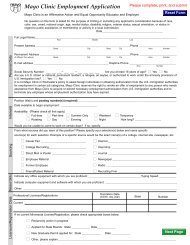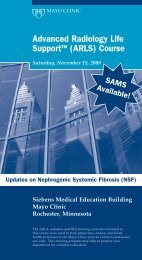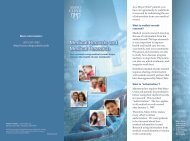current issue - Mayo Clinic
current issue - Mayo Clinic
current issue - Mayo Clinic
Create successful ePaper yourself
Turn your PDF publications into a flip-book with our unique Google optimized e-Paper software.
??<br />
?<br />
Excitement for research nurtured at<br />
<strong>Mayo</strong> <strong>Clinic</strong> thrives today in solving global<br />
environmental health problems<br />
William J. Martin II, M.D., says the Balfour Award he<br />
received in 1979 launched his research career.<br />
“The award changed my life,” he says. “<strong>Mayo</strong>’s generous<br />
support at that critical moment in my career created<br />
opportunities that I would never have considered possible<br />
and led me to the National Institutes of Health (NIH). I remain<br />
grateful to <strong>Mayo</strong> and to those who created the award to foster<br />
career development of <strong>Mayo</strong> fellows.”<br />
Dr. Martin grew up in Rochester, and his father, William<br />
J. Martin, M.D. (I ’49), was on the <strong>Mayo</strong> <strong>Clinic</strong> staff.<br />
“I was very familiar with the opportunities at <strong>Mayo</strong> from<br />
an early age,” says Dr. Martin. He completed his residency<br />
in internal medicine and a pulmonary fellowship at <strong>Mayo</strong><br />
<strong>Clinic</strong>. “I was interested in using biochemistry and cell<br />
biology to better understand how lung diseases develop.<br />
The Balfour Award permitted me to go to the NIH’s National<br />
Heart, Lung, and Blood Institute, Pulmonary Branch, as a<br />
research fellow for two years, working in one of the best<br />
scientific laboratories in the United States and studying the<br />
mechanisms of lung disease.<br />
“<strong>Mayo</strong> made it clear that a Balfour Award recipient<br />
would be welcomed back on staff or, if you were recruited<br />
elsewhere, the award was a wise investment in the future<br />
of medicine.”<br />
He returned to <strong>Mayo</strong> <strong>Clinic</strong> in 1981 as a consultant in<br />
the Division of Pulmonary and Critical Care Medicine and<br />
established an NIH-funded research laboratory. After seven<br />
years on staff, he left <strong>Mayo</strong> <strong>Clinic</strong> to become director of the<br />
pulmonary/critical care division at Indiana University.<br />
Under his leadership for 12 years, the division grew fivefold<br />
and increased its NIH research funding by thirtyfold.<br />
During that period, he served one year as a health policy<br />
fellow for Sen. Edward Kennedy, working on legislation<br />
related to health care, the Food and Drug Administration<br />
and the NIH. Dr. Martin became associate dean for clinical<br />
affairs at Indiana University School of<br />
Medicine, president of Indiana University<br />
Health Care and, later, dean of the College<br />
of Medicine at the University of Cincinnati.<br />
He also served as president of the American<br />
Thoracic Society.<br />
Having a change of heart after a hurricane<br />
In 2005, Dr. Martin’s career focus shifted from<br />
academic medicine to global health after he<br />
served four weeks as a volunteer physician<br />
with Project Hope on the U.S. Navy hospital<br />
ship USNS Comfort, tending to the people<br />
of coastal Mississippi after Hurricane Katrina.<br />
“The health care infrastructure support was<br />
destroyed, and the human health needs were<br />
William J. Martin II, M.D. (right), was a consultant<br />
in the Division of Pulmonary and Critical Care<br />
Medicine during the 1980s.<br />
2013 | No. 1 15



